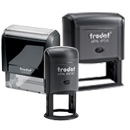When using rubber stamps, there is always a risk of getting ink on yourself or your clothes. Don’t panic! Here are some quick tips from your Trodat rubber stamp experts at the Rubber Stamp Station on how to remove ink from your hands and clothes.
Cleaning Ink Off Bare Skin
If you get ink on your skin, you only need a few supplies to clean it off:
- Rubbing alcohol
- Paper towels
- Gojo (or similar soap containing pumice)
It is simple enough to clean most of the ink off bare skin with rubbing alcohol and a paper towel. Once a majority of the ink has been removed, you can simply wash the rest of it off with warm water and a soap containing pumice such as Gojo. Any leftover discoloration of the skin should disappear within 24 hours.
If you are unlucky enough to get the ink on clothing or upholstery, the cleaning process gets a little more complicated. There are several options to try.
Cleaning Ink Off Fabrics
Option 1
You will need a few supplies:
- 1 quart warm water
- ½ tsp. dishwashing detergent
- 1 tbsp. ammonia
All these ingredients get mixed together to create a solution in which the stained fabric should be soaked for half an hour. After soaking, the fabric should be rinsed well in warm water. If some ink still remains, it is time to move on to the next option.
Option 2
This is not a good option for cotton or linen based fabrics, but should work on most others. The supplies you will need include:
- 1 quart of warm water
- 1 tbsp. white vinegar
These should be mixed to create a solution in which the stained fabric should be soaked for one hour before rinsing in warm water. If some staining still remains, there is a third option to try.
Option 3
This option requires:
- Rubbing alcohol diluted with warm water in a 1:1 ratio
- Paper towels or cotton balls
Dilute the rubbing alcohol with warm water and use a paper towel or cotton ball to apply the solution directly to the stain. Hold the solution over the stain until it begins to loosen. When the stain begins to loosen, gently dab it away. Depending on the size and severity of the stain, you may need to reapply this several times before the stain begins to dissipate. Once you have gotten as much of the stain out as possible, rinse thoroughly with warm water.
Keys to Success
- Always use warm water as this will loosen the stain and make your job easier. Cold water will set the stain and make cleaning ink stains that much more difficult.
- The sooner you remove the stain, the more you will be able to get out. The longer you wait, the less you will be able to salvage, especially with delicate fabrics.
We hope you get that stain out! On the other hand, you may want to leave a mark on fabric—you can use a clothing marker stamp to leave an identifying impression on clothes, towels, uniforms, etc. Never lose a garment or accessory again!
If you have any questions about our rubber stamps or the ordering process on our website, give us a call at 1 (850) 7STAMPS. We look forward to chatting with you!
When using rubber stamps, there is always a risk of getting ink on yourself or your clothes. Don’t panic! Here are some quick tips from your Trodat rubber stamp experts at the Rubber Stamp Station on how to remove ink from your hands and clothes.
Cleaning Ink Off Bare Skin
If you get ink on your skin, you only need a few supplies to clean it off:
- Rubbing alcohol
- Paper towels
- Gojo (or similar soap containing pumice)
It is simple enough to clean most of the ink off bare skin with rubbing alcohol and a paper towel. Once a majority of the ink has been removed, you can simply wash the rest of it off with warm water and a soap containing pumice such as Gojo. Any leftover discoloration of the skin should disappear within 24 hours.
If you are unlucky enough to get the ink on clothing or upholstery, the cleaning process gets a little more complicated. There are several options to try.
Cleaning Ink Off Fabrics
Option 1
You will need a few supplies:
- 1 quart warm water
- ½ tsp. dishwashing detergent
- 1 tbsp. ammonia
All these ingredients get mixed together to create a solution in which the stained fabric should be soaked for half an hour. After soaking, the fabric should be rinsed well in warm water. If some ink still remains, it is time to move on to the next option.
Option 2
This is not a good option for cotton or linen based fabrics, but should work on most others. The supplies you will need include:
- 1 quart of warm water
- 1 tbsp. white vinegar
These should be mixed to create a solution in which the stained fabric should be soaked for one hour before rinsing in warm water. If some staining still remains, there is a third option to try.
Option 3
This option requires:
- Rubbing alcohol diluted with warm water in a 1:1 ratio
- Paper towels or cotton balls
Dilute the rubbing alcohol with warm water and use a paper towel or cotton ball to apply the solution directly to the stain. Hold the solution over the stain until it begins to loosen. When the stain begins to loosen, gently dab it away. Depending on the size and severity of the stain, you may need to reapply this several times before the stain begins to dissipate. Once you have gotten as much of the stain out as possible, rinse thoroughly with warm water.
Keys to Success
- Always use warm water as this will loosen the stain and make your job easier. Cold water will set the stain and make cleaning ink stains that much more difficult.
- The sooner you remove the stain, the more you will be able to get out. The longer you wait, the less you will be able to salvage, especially with delicate fabrics.
We hope you get that stain out! On the other hand, you may want to leave a mark on fabric—you can use a clothing marker stamp to leave an identifying impression on clothes, towels, uniforms, etc. Never lose a garment or accessory again!
If you have any questions about our rubber stamps or the ordering process on our website, give us a call at 1 (850) 7STAMPS. We look forward to chatting with you!







